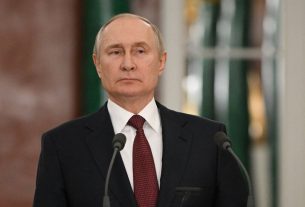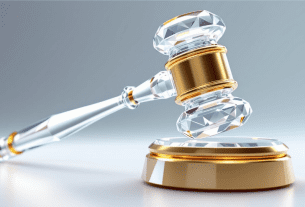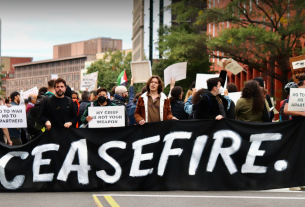|
Getting your Trinity Audio player ready...
|
(JTA) – Typing “Hitler” into the search bar on Netflix yields an array of Holocaust and World War II-themed movies and TV shows, many of them with one Nazi or another in their titles.
A viewer who has consumed any of that content might expect something fresh – a piece of bombshell news unearthed in newly found documents, or the use of some kind of flashy new cinematic technology – to headline the newest such addition to the streaming giant, “Hitler and the Nazis: Evil on Trial.”
That kind of viewer might be disappointed. The six-part documentary – which flashes back and forth between a chronicling of the Nuremberg Trials and a chronicling of Hitler’s methodical rise to power – doesn’t offer much if anything new, content-wise.
The difference, however, is in the packaging, and that’s the framework that started the project. The series uses archival footage and audio and makes use of the standard talking-heads format. But with the help of dramatically recreated scenes from history and frequent flashbacks, it’s constructed more like a narrative thriller miniseries than a documentary.
Director Joe Berlinger – who’s well known among true-crime documentary fans for films such as “Brother’s Keeper” and his “Conversations With a Killer” series – told the Jewish Telegraphic Agency that the content lent itself to a gripping retelling that hasn’t been pulled off in the documentary space.
“How this has been presented in the past is just your information blabbed at you by historians,” Berlinger said. “And there’s no effort to contextualize and to humanize.”
He was motivated at the start by something more specific: a Claims Conference survey from 2020 that found disturbingly high levels of Holocaust ignorance among millennials and Gen Z.
Netflix wouldn’t comment on its decision to distribute the series, but Berlinger noted that the streaming giant is increasingly looking to wade further into the realm of historical documentary content. (It has also made recent forays into the religion film market, with a documentary about Moses.)
“This grew out of [Netflix] wanting to try the history bucket, which they hadn’t yet kind of tackled,” he said.
Berlinger spoke to JTA about making World War II feel new again, his own Jewish journey and how his documentary about fascism in the past dovetails with the present.
This interview has been lightly edited and condensed for clarity.
Is there anything new ground covered here, stylistically, historically or otherwise?
Berliner: There obviously have been many, many series about Hitler. There are whole channels devoted to World War II, nonstop all the time. But that stuff always feels very dusty and creaky. It’s like grainy, black and white archival footage intercut with mediocrely shot interviews. And that’s really kind of what it’s been. We really pushed the envelope [drama-wise].
We also restored and colorized archival footage, I don’t know if you noticed that that’s fresh. I wanted that restored and colorized so that it would nicely intercut with a very high level of cinematic technique for the recreations. They don’t feel like cheesy Discovery ID or Oxygen network level of just the worst kind of recreation you’ve seen.
Why the timing now, exactly?
One of the reasons I wanted to do this is the level of ignorance about the Holocaust amongst millennials is so high. As well as just people not understanding the history. It’s to the point where what’s really scary was it used to be Holocaust denial, but now it’s moved into Holocaust affirmation, like Hitler was right. There’s such ignorance.
There was a study of millennials that the Conference on Jewish Material Claims Against Germany put out, which was one of the sparks to why I wanted to do this. It found that one in 10 thought the Jews started the Holocaust, and 50% can’t even name a single concentration camp. That level of ignorance told me that it’s time to retell this story for a younger generation.
How do you reach those millennials and younger generations in the vast forest of content?
Netflix particularly is a great platform because it has a huge global audience and a younger scaling audience. So how do you reach a younger scaling global audience? Well, you use the language of cinema, you know, instead of just creaky, poor production value. Talking heads intercut with just archival footage, of course, we have that. But our interviews are beautifully shot. I wanted to use kind of a stage, like you’re getting a lecture from these professors.
I also leaned into the Nuremberg Trials as kind of the present tense thread of the show. Now, there have been documentaries about Nuremberg, but structurally using the Nuremberg Trials as kind of the present tense and then flashing back and forth to tell the history felt fresh.
I do a lot of true crime. And one of the reasons I’m attracted to the trial format is that it’s got perfect dramatic structure: there’s a beginning, middle and end. There’s a search for the truth, there’s rising and falling action, there’s a protagonist and antagonist, then a resolution. So that’s why I gravitated to the true-crime form. Putting the Nazi story into this format, the murder trial format, the criminal format, I thought was a great storytelling device.
And there are certain things that are visual that communicate in ways that you can’t get from just hearing somebody talk. In episode five, it’s hair-raising, you know, we made the bold choice to recreate Babyn Yar, the “Holocaust by bullets” where 30,000 Jews were murdered outside of Kyiv. [The shootings put] such emotional stress on the German soldiers that they decided shooting is too messy – that’s what led to the decision to gas Jews and others in the Holocaust.
If you just hear somebody blab that at you, and you’re looking at old scratchy footage, it just does not reach you the way cinema can reach you. So we recreated it, there’s a certain level of visual storytelling that communicate certain things that you can just never get in an interview.
Can you talk about journalist William Shirer, who’s one of the main narrators of the series – thanks to AI voice recreation – but is not widely known today?
William Shirer’s book “The Rise and Fall of the Third Reich” (1960), with a swastika on the spine, that was the book. It’s not the only book people read anymore, but he had a unique position because he was one of the few American reporters who was in Nazi Germany at all these pivotal moments, eyewitnessing stuff. And as you’ll see in the series, he’s greatly censored about what he can report while he was in Germany, but he smuggled out his diaries. And he was one of the first people to alert us of the dangers of what happened. Now with our phones and cameras and social media and everything being instantaneous, you can hardly wrap your head around the fact that there used to be a time when we didn’t know anything and journalists had to embed and send out radio reports and all that stuff.
And directly related to how much Holocaust denial and ignorance there is – Shirer was an eyewitness. You can’t dispute an eyewitness, and we have eyewitness testimony throughout the show. So all of these things kind of came together thematically.
Was your own Jewishness part of the inspiration for tackling this project?
The thing that’s most fascinating for me about this project is that it actually kind of relates to my origin story as a filmmaker. I grew up in Westchester County [in New York]; we were comfortable. But we were very secular Jews in Westchester. There’s a particular secular Jew in Westchester. I didn’t really feel like I had a Jewish identity growing up. My mother’s side of the family came over from Poland, and my father’s side of the family came over from Germany, but in the 1850s. So we had no German traditions at home, because we were long assimilated, we didn’t lose anybody in the Holocaust.
But when I saw Holocaust liberation footage when I was 14 or 15, it just blew me away. I don’t claim that I was more disturbed than other people, but I just couldn’t get it out of my head. And I kept ruminating on the fact that I’m Jewish, but not really, we’re not really practicing or observing Jews – and German, but not really. But had I been born in that time, I clearly would have been murdered, and I just couldn’t get it out of my head.
So when I went to college, I decided to become a German major and learn the language and learn the culture because I really wanted to understand. I went to Colgate University, graduated in 1983, no idea that I wanted to be a filmmaker; it was the late 70s liberal arts college like “I have no idea what I want to do for a living.” But by the time I had graduated, I was fluent in German, I had understood the culture, I had a greater understanding of how this evil had happened. So my only career goal in college was: “How can I live in Germany and have someone pay me to speak German?”
I was interviewing with insurance companies and Ciba-Geigy pharmaceuticals, because they were in Switzerland. I ended up at the Frankfurt office of a big New York ad agency called Ogilvy and Mather, where I became a junior producer. The first time I was ever on a film set was circa 1984, for an American Express commercial being shot in Germany. And that’s when the light bulb went off. I’m like, “Oh, lights, camera, action, that sounds cool. The hell with his language stuff, I’m gonna go become a filmmaker.”
There were a couple of Germans on the [Netflix] project, and I was correcting them – I’m like, “No, that’s not the right translation.” The whole thing has been a fascinating journey, and sadly, it’s become way more topical than I thought it would be when we started the project.
Speaking of its topical nature – I was getting Trump trial notifications on my phone while watching a point in an episode about Hitler’s jail time after the Beer Hall Putsch.
What do you think of all the comparisons between Hitler and Trump, who many fear would further erode American democratic institutions if elected president again? Several of the expert narrators of your series draw parallels, using language like “make Germany great again.”
The Berghof, the Eagle’s Nest, even the interviewer says it was like Hitler’s Mar-a-Lago.
The parallels of populism, antisemitism, appealing to a disenfranchised white audience pining for the good old days – all of that felt like “wow.” And there’s the parallel of how close we came to losing our democracy, which some people still don’t get. In the series we see just how Hitler took over power, quite easily. First he tried to overthrow [Germany] with the Beer Hall Putsch and when pure revolution wasn’t going to work for him, he realized he had to dismantle the system from within. And he did so in pretty quick order. He didn’t seize it violently. He convinced the parliament to take away their own powers. He used the Reichstag fire to shut down civil liberties.
But even I – who has made a six-part series on the rise of Hitler, and have taken every opportunity in the edit to shine a flashlight on similarities to today – think it’s a very slippery slope to say that history will repeat itself. Mark Twain said “history rhymes,” but I don’t think you’ll have a U.S. version of the Gestapo running around and such a dismal breakdown in our basic rights.
But we already have a distrust in institutions that I think the Trump era helped spawn. We already have a belief in a strong man. We already have otherized each other. I mean, that’s the problem with with the kind of rhetoric that Trump normalized, is we’ve divided into two camps who hate each other and we’ve dehumanized each other. And you can’t have democracy when there is not a feeling of a collective good.
So I do think democracy is under attack. I do think if Trump wins again, we will see democracy further crumble, we will have further erosion and basic respect for one another, and lack of belief in our institutions. But I don’t think there’s going to be blackshirts goosestepping down Fifth Avenue. Somewhere in between.


